FEBRUARY 2015
From Victim to Offender?
New Study Questions Child Sex Abuse as Predictor of Future Crimes
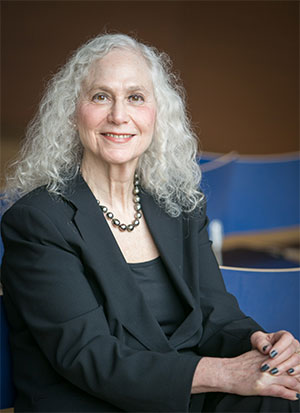 Childhood sexual abuse does not pose a uniquely heightened risk for future arrests for sex crimes, according to Distinguished Professor of Psychology Cathy Spatz Widom, who has devoted much of her career as a scholar and researcher to studying the long-term cycle of violence.
Childhood sexual abuse does not pose a uniquely heightened risk for future arrests for sex crimes, according to Distinguished Professor of Psychology Cathy Spatz Widom, who has devoted much of her career as a scholar and researcher to studying the long-term cycle of violence.
Widom’s latest paper on the subject, “A Prospective Examination of Whether Childhood Sexual Abuse Predicts Subsequent Sexual Offending,” was co-authored with doctoral student Christina Massey, and published in the current issue of the Journal of the American Medical Association-Pediatrics (JAMA Pediatrics).
The researchers examined the records of 908 cases of abused and neglected children from 1967 to 1971 and matched them with 667 control individuals – non-abused and non-neglected children – from the same metropolitan area. Individuals from both groups were followed into middle age (median age, 51 years). Of those with arrests for sex crimes, 6.61 percent had records that included only sex offenses and only 9.52 percent of the sex offenders met the criteria for sex crime specialization.
Individuals with histories of childhood abuse and neglect were generally at an increased risk for being arrested for sex crimes, compared with the control individuals. However, for individuals with histories of childhood sexual abuse, the increase in risk for arrest for sex crimes did not reach a statistical significance, the researchers found.
Physically abused and neglected boys had an increased risk of being arrested for a sex crime as an adult. However, sexually abused children of both genders were not at unique risk. Most individuals arrested for a sex crime also had arrests for other types of offenses.
Spatz and Massey concluded: “These results do not provide support for the common belief that being a survivor of childhood sexual abuse carries with it unique increase in the risk for becoming a sex offender, contrary to some public policy and administrative practices of jurisdictions where children may have been stigmatized, placed in restrictive settings, or barred from schools.” They suggest that early intervention programs should target children with a history of physical abuse and neglect.
For more information about the study, click here.
Forensic Science in the U.S. to Get an Overhaul, and John Jay Is in the Vanguard
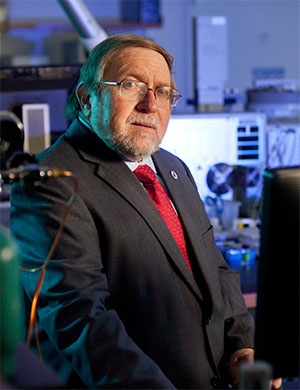 John Jay’s forensic science program has added several feathers to its cap with the appointments of a dozen faculty members and alumni to the federal government’s new Organization for Scientific Area Committees (OSAC).
John Jay’s forensic science program has added several feathers to its cap with the appointments of a dozen faculty members and alumni to the federal government’s new Organization for Scientific Area Committees (OSAC).
OSAC and the Forensic Sciences Standards Board that oversees it are part of an initiative by the U.S. Commerce Department’s National Institute of Standards and Technology (NIST) and the Justice Department to improve and strengthen forensic science in the United States.
In addition, Professor Lawrence Kobilinsky, Chair of the Department of Sciences, has been named to a key subcommittee of the National Forensic Science Commission, a policy-making unit of the Justice Department. Kobilinsky will serve as a member of the commission’s Subcommittee on Report Writing and Testimony. The John Jay contingent to OSAC, meanwhile, includes Kobilinsky’s faculty colleagues Nicholas D.K. Petraco and Mechthild Prinz, and retired professor Peter DeForest.
“This is huge!” Kobilinsky said. “I don’t think there’s any other institution that has as many representatives on the commission and OSAC. I know of some that are proud to have one — and we have a dozen!”
OSAC comprises five Scientific Area Committees: Biology/DNA; Chemistry/Instrumental Analysis; Crime Scene/Death Investigation; Physics/Pattern Interpretation, and Digital/Multimedia. These in turn are broken down into 24 subcommittees addressing specialized areas of forensic science. Petraco has been appointed to the Physics Pattern Scientific Area Committee, DeForest to its Subcommittee on Bloodstain Pattern Analysis, and Prinz to the Biology/DNA Scientific Area Committee’s panel on DNA analysis (interpretation).
Attesting to the strength of John Jay’s forensic science curriculum, eight alumni and one current doctoral student will serve on OSAC committees and subcommittees. These include JoAnn Buscaglia (Physics Pattern SAC); Ralph Ristenbatt III and doctoral student Peter Valentin (Subcommittee on Bloodstain Pattern Analysis); Aurora Dumitra and Jacqueline Speir (Subcommittee on Footwear and Tire Tread); Vincent Desiderio (Chemistry/Instrumental Analysis SAC); Desiderio and Philip Antoci (Subcommittee on Fire Debris and Explosives); Jack Hietpas (Subcommittee on Geological Materials), and James Garcia (Subcommittee on Gunshot Residue).
Under the terms of its charter, the forensic science commission is charged with providing recommendations to the Justice Department concerning national methods and strategies for:
- Strengthening the validity and reliability of the forensic sciences (including medico-legal death investigation);
- Enhancing quality assurance and quality control in forensic science laboratories and units;
- Identifying and recommending scientific guidance and protocols for evidence seizure, testing, analysis, and reporting by forensic science laboratories and units; and
- Identifying and assessing other needs of the forensic science communities to strengthen their disciplines and meet the increasing demands generated by the criminal and civil justice systems at all levels of government.
“This is going to significantly impact the practice of forensic science in the United States, as well as education in the field,” Kobilinsky noted. “We’ll be looking at standards for different forensic science disciplines, and what practitioners should be focusing on when faced with this evidence.”
The national commission is scheduled to hold public meetings in Orlando, Fla., this month in conjunction with the annual conference of the American Academy of Forensic Sciences. The meetings will include presentation and discussion of the work that has been accomplished thus far, and priorities for developing standards and guidelines for each forensic science discipline.
Kobilinsky said there is no timetable that he is aware of for delivery of the final set of standards and guidelines. “They’ll keep at it until they get it right,” he said.
Read All About It!
Reporters Honored for Shining a Spotlight on “Dark Corners of Justice System”

John Jay’s Center on Media, Crime and Justice on Feb. 9 paid its annual tribute to intrepid journalists who focus on justice-related issues, presenting the John Jay College/Harry Frank Guggenheim 2015 Awards for Excellence in Criminal Justice Reporting to reporters from The New Yorker magazine and The Post and Courier in Charleston, S.C., and the John Jay Justice Trailblazer prize to a veteran broadcast journalist.
Maria Hinojosa, the anchor and executive producer of National Public Radio’s only Latino news and culture show, “Latino USA,” was honored as the 2015 Justice Trailblazer. Hinojosa is also the host and executive producer of the upcoming PBS show “America by the Numbers with Maria Hinojosa.” Both shows are produced by Futuro Media, an independent nonprofit organization she founded in 2010 to produce multimedia journalism about diverse American communities. Hinojosa’s stories have included exposés on prison hunger strikes, immigration detention and teenage victims of sexual harassment.
The Trailblazer award honors individuals from the media and related fields who have expanded public awareness about the challenges and complexities of criminal justice. The award was presented by John Jay President Jeremy Travis and Rossana Rosado, former CEO of El Diario/La Prensa and now a Distinguished Lecturer at John Jay.
The reporting prizes recognize the best work published by U.S.-based print and online journalists, with special emphasis given to work that has had an impact on public policy or debate.
In the single-story category, Jennifer Gonnerman of The New Yorker won the Excellence in Criminal Justice Reporting Award for “Before the Law,” her chilling account of Kalief Browder, a Bronx teen-ager who was accused of stealing a backpack and spent more than 1,000 days awaiting trial before he was released with no charges filed. Gonnerman’s seven-month investigation led to calls for a review of sentencing policy in the New York State Senate.
The investigative team of Doug Pardue, Glenn Smith, Jennifer Berry Hawes and Natalie Caula Hauff from The Post and Courier won the reporting award in the series category for their five-part report on "Till Death Do Us Part," which explored why South Carolina leads the nation in domestic-violence homicides of women.
“This year’s winners prove once again that powerful journalism can drive change and open to public view the darker corners of our justice system,” said Travis. “The Justice Trailblazer Award and the Guggenheim Prizes for Excellence in Journalism have become an important part of the media landscape and valued barometers for gauging the most pressing justice issues.”
An honorable-mention in the single-entry category was awarded to Beth Schwartzapel of American Prospect for "The Great American Chain Gang," an article that explored prison work across the country. In the series category, runner-up citations went to the reporting team of Bob Ortega and Rob O’Dell of The Arizona Republic for “Force at the Border," which examined the deadly-force practices of the U.S. Customs and Border Protection agency, and to the reporting team of Jerry Mitchell, Emily Le Coz, Jackie Mader, Kate Royals, Monica Land and Sarah Butrymowicz of the Jackson, Miss., Clarion-Ledger for the 13-month investigation of the state’s prison system, “Hard Look at Hard Time.”
The awards were presented at a dinner held in conjunction with the 10th annual John Jay/Harry Frank Guggenheim Symposium on Crime in America. The winning entries will be posted on the John Jay Center on Media, Crime and Justice website, http://www.jjay.cuny.edu/cmcj/.
It’s a Bold New Era for John Jay’s Website
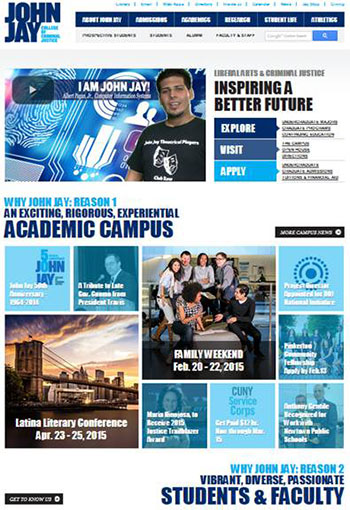 The product of nearly three years of planning and development by John Jay’s in-house Web team and an award-winning outside contractor, the College’s new website made its debut on Feb. 2, and all visitors and users will quickly feel the impact of the site’s sleek new design, enhanced content and improved navigation, among other upgrades.
The product of nearly three years of planning and development by John Jay’s in-house Web team and an award-winning outside contractor, the College’s new website made its debut on Feb. 2, and all visitors and users will quickly feel the impact of the site’s sleek new design, enhanced content and improved navigation, among other upgrades.
The new site is replete with John Jay’s distinct branded style, and features bold, colorful graphics throughout its roughly 5,000 separate pages. The new home page leads off with an inviting portal under the title of “Liberal Arts & Criminal Justice: Inspiring a Better Future,” which links to a video of students proclaiming “I Am John Jay” as they talk about themselves and their college experience. As the user scrolls down, the home page reveals four broad subdivisions under the generic heading of “Why John Jay”: “An Exciting, Rigorous, Experiential Academic Campus”; “Vibrant, Diverse, Passionate Students & Faculty”; “Cutting-Edge, Smart, Compelling Research & Global Community,” and “Enlivening, Uplifting and Provocative Events 24/7/365.”
Created in conjunction with Blue Fountain Media, the site is the outgrowth of extensive research, including virtual and in-person focus-group sessions with constituencies ranging from President Jeremy Travis and John Jay College Foundation board members to students, faculty and alumni. The research produced five overarching goals for the new site: flexibility and ease of updating content; improved navigation; responsive design, which automatically reconfigures the site’s pages to the size of any mobile device; clear pathways to access key information; enhanced Web tools, and integrated multimedia content, including video and social media links.
In addition to the research, Blue Fountain Media designed the site’s “wire frame” and organizational schematic, while the John Jay team implemented the design and filled in the substance “If BFM were the architects, we were the interior decorators,” quipped Johnny Taveras, the College’s Director of Web Services.
“A new Content Management System (CMS) forms the building block for this new site, providing far more flexibility and ease of use than we’ve had before,” said Vice President for Marketing and Development Jayne Rosengarten. The site features the same content management system as is used by the White House, Taveras noted.
In the weeks ahead, CMS training sessions will be held for Web content coordinators across campus departments and offices.
The opening video of students was created under the direction of Amala Lane, senior producer in the Video Production office. “We had a number of discussions as to the theme,” said Taveras, “and came up with ‘I Am John Jay.’” The video is a linchpin of the new site, Rosengarten noted. “In combination with the enhanced use of images across many pages, this display of multimedia content allows for a visually compelling presentation of John Jay’s strengths and distinctions,” she said.
Visitors to the site will also find easy, direct links to John Jay’s presence on YouTube and social media, including Facebook, Twitter and Pinterest. Coming soon to the site will be a live-streaming capability to mobile devices, Taveras observed.
The site’s best upgrade, in Taveras’s estimation, is its responsiveness to various mobile devices, such as smart phones and tablets. The feature is a first on CUNY college websites, he noted.
Throughout the site’s long gestation, the toughest challenge was linking the CMS to the College’s active directory of names, contact information and other data, a task that was managed by Taveras’s Web team, the Department of Information Technology and Blue Fountain Media. Underscoring the security of the approach that was ultimately used, Taveras pointed out that no personal data is stored on the College website, making it unfriendly to would-be hackers.
The website designers also had to decide on an appropriate search engine for the site, one that “was robust and 21st-century capable,” said Taveras. The Google custom search tool that was chosen has an onboard logic that makes searching the site faster, simpler and more intuitive.
11 Inaugural Siegel Fellows Make Their Debut
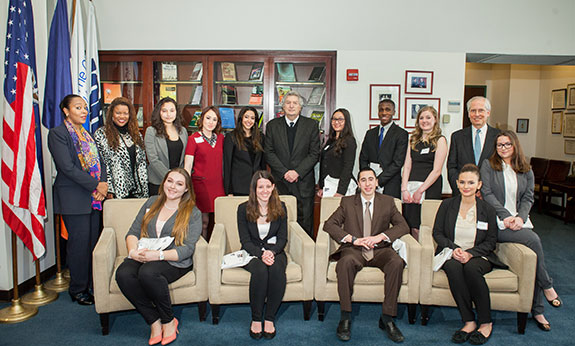
Eleven John Jay students have been named to the inaugural cohort of Siegel Fellows in Strategic and Nonprofit Communication, funded by a John Jay College Foundation trustee who is a pioneer and visionary in the branding and communications fields.
Alan Siegel, the president and CEO of Siegelvision, created the fellowships as a five-semester certificate program intended to teach best practices in strategic communications in the public and nonprofit sectors.
A new group of at least 10 sophomores will be chosen each year for the fellowships, in which they will be immersed in the world of strategic thinking and taught how to improve communication within and between organizations and their audiences. The program will consist of a core curriculum of five strategic communications courses, including a senior-year internship, and a workshop series of mini-courses or case studies. The mini-courses will be based on Siegelvision’s diverse client portfolio and, wherever possible, will be taught by those who designed the campaign.
Seniors in the fellowship program will collaborate with branding professionals on a public communication issue or campaign, and present their research and/or creative work at a Siegel Symposium in the spring semester of their senior year
The Siegel Fellowship program, directed by Professor Dara Byrne, is aimed at motivated students with a minimum GPA of 3.3, among other criteria. Fellows will receive a stipend each semester, along with an iPad and other perks. The inaugural Siegel Fellows are:
Ajibola Allison is a Criminal Justice B.A. major whose goal is a career in some aspect of crisis communications or community outreach initiatives for major corporations.
Naomi Haber, a CUNY B.A. student in Mass Media, Rhetoric and Public Opinion, has a passion for political campaign strategy, which she hopes to turn into a career.
Ardijana Ivezic is a Criminal Justice B.A. major who aspires to a career as a researcher or policy analyst. As a freshman she was an intern at the U.S. Equal Employment Opportunity Commission.
Kelly Kondroski, a double major in Forensic Psychology and Criminology, plans to pursue both J.D. and Ph.D. degrees, with a career goal of influencing policies affecting persons with mental disabilities.
Amarel Levy, a B.A./M.A. student in Forensic Psychology, is passionate about world culture, and is aiming for a career as a psychologist with the FBI.
Vincent Palmeri, who is majoring in English, plans to use his interest in communication as a springboard to law school and a career as an attorney, judge or in public office.
Justine Brittany Rayborn is a B.A./M.A. student in Forensic Psychology intends to pursue a Ph.D. in Clinical Psychology and a career working with troubled youth and juvenile offenders.
Leslie Smith-Ramirez, a Philosophy major, has her sights set on a career in international law, so she can be an effective advocate for important causes in countries that need urgent solutions.
Fatime Uruci, a double major in English and Philosophy, aspires to a career in international affairs and foreign service.
Nicole Mary Vitrit, a Law and Society major, hopes to integrate strategic communication into a career with the U.S. Department of Homeland Security.
Loyana Webb, an English major, is focused on becoming an educator for an international nonprofit organization. She is particularly interested in working with victims of abuse.
On September 18, John Jay dedicated the Alan Siegel Writing Center in recognition of Siegel’s generosity and his commitment to building a world-class communications program for the College. Siegel, who developed the College’s brand identity keyed to the theme of “Fierce Advocates for Justice,” was praised by President Jeremy Travis as one whose “dedication and vision have helped to communicate and solidify John Jay’s position as the preeminent leader in educating for justice.”
Center Official Honored for Safety Consulting with Newtown Schools
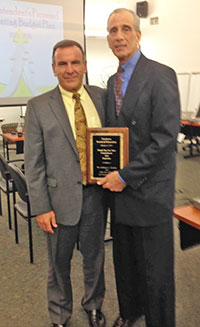 In the aftermath of the December 2012 school shootings that claimed the lives of 26 students and teachers in Newtown, Conn., Anthony Gentile of John Jay College’s Center for Private Security and Safety reached out to offer his professional talents – and those of the Center and the College – to help create a safer learning environment for the school district.
In the aftermath of the December 2012 school shootings that claimed the lives of 26 students and teachers in Newtown, Conn., Anthony Gentile of John Jay College’s Center for Private Security and Safety reached out to offer his professional talents – and those of the Center and the College – to help create a safer learning environment for the school district.
On Jan. 6, the Newtown Public Schools presented Gentile with an award for his unstinting – and pro bono – efforts. “I would like to recognize your dedication and much appreciated work on the Newtown Public Schools Security Committee,” noted School Superintendent Dr. Joseph V. Erardi Jr.
“After the tragedy, I thought it best to contact Newtown and offer the resources of the Center and the College,” said Gentile, who is the Center’s CEO and Associate Director. The ongoing relationship with the Newtown school system included a thorough risk assessment, real-time and tabletop training initiatives for school safety and administrative personnel, and new security policies and procedures.
“Anthony Gentile has dedicated long, tireless hours of service to the Sandy Hook community, and done so with admirable care and concern, bringing to bear his nearly 30 years of experience in the security sector,” said Professor Charles Nemeth, Chair of the Department of Security, Fire and Emergency Management, and the Center’s Director. “The award reflects how Tony’s presence at Sandy Hook is both a comfort and a sign of confidence in his insights and the positive role both the Center and John Jay College have played in the aftermath of the Newtown tragedy.”
Gentile, a veteran of the security and safety fields and an adjunct faculty member in the Department of Security, Fire and Emergency Management, says his work with the Newtown school district is a personal high-water mark. “It’s the most important professional work I’ve ever done in my career.” he said.
[The Center for Private Security and Safety is dedicated to professionalization of the private security industry and its safety constituencies in fire and emergency management. The Center is designed to developing joint partnerships with both the public and private safety providers and to serving corporate, educational and industrial institutions in need of guidance through best practices and current industry standards at the local, state, national and international level. For more information, visit click here.]
John Jay College Wins Westy Award
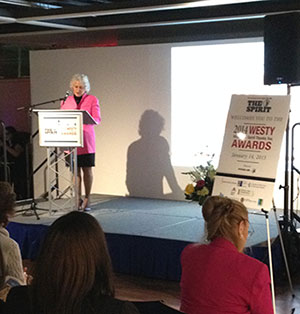
Jeanne Straus, president of Straus News, presented John Jay College, along with 16 other prominent members of the Upper West Side, with at WESTY Award for civic engagement. The ceremony took place on January 14 in the Anya and Andrew Shiva Gallery.
In a pre-recorded message, President Jeremy Travis thanked Straus News and its president, Jeanne Straus, as he accepted the award on behalf of John Jay College.
“Over the years that John Jay has been a member of the West Side community, we have really treasured, nurtured and valued our friendships and relationships with our community partners…all of the entities that make up the spirit of the West Side. If you think about it, as we celebrate our 50th anniversary, we have really grown up together. The West Side is now known worldwide for being one of the most vibrant parts of our vibrant city. John Jay College is now known worldwide as a unique, powerful and important institution and our mission of educating for justice has never been more important than it is today. On behalf of the college, our students, faculty and alumni all around the world, I accept the WESTY Award,” said President Travis.
Click here to read Strauss Media coverage of the WESTY Awards.
During the ceremony, honoree Cyrus Vance, Manhattan District Attorney, spoke of the importance of better cooperation between law enforcement and communities. Among the attendees were elected officials such as State Senators Bill Perkins and Brad Hoylman; Assembly Members Linda B. Rosenthal and Daniel O’Donnell; Councilmembers Helen Rosenthal and Mark Levine; Borough President Gale Brewer; and Public Advocate Letitia James, who highlighted the contributions of the honorees as they presented each with their WESTY Award.
Over 120 West Side residents filled the Shiva Gallery to cheer on their neighbors.
Faculty/Staff Notes
On Board
 Scott Stoddart (Academic Affairs) has been named Associate Provost and Dean of Undergraduate Studies. Stoddart, whose academic specialty is American Literature and Cinema, previously served as the Dean of the School of Liberal Arts at the Fashion Institute of Technology (SUNY). He has also been acting Provost and Senior Vice President for Academic Affairs at Manhattanville College, and the Academic Dean at Marymount Manhattan. Professor Allison Pease, who had been serving as interim Associate Provost and Dean, returns to her position as Chair of the Department of English.
Scott Stoddart (Academic Affairs) has been named Associate Provost and Dean of Undergraduate Studies. Stoddart, whose academic specialty is American Literature and Cinema, previously served as the Dean of the School of Liberal Arts at the Fashion Institute of Technology (SUNY). He has also been acting Provost and Senior Vice President for Academic Affairs at Manhattanville College, and the Academic Dean at Marymount Manhattan. Professor Allison Pease, who had been serving as interim Associate Provost and Dean, returns to her position as Chair of the Department of English.
Presenting. . .
David Kennedy (Center for Crime Prevention and Control) was interviewed on the WNYC radio program “Here's the Thing” about the development of his Group Violence Intervention initiative. Kennedy explained how the intervention was first implemented in Boston as "Operation Ceasefire," and how it continues to work around the country to reduce violence, minimize arrest and incarceration, and strengthen relationships between law enforcement and distressed communities. Click here to listen to the interview.
Monica Varsanyi (Political Science) discussed recent developments in U.S. immigration policy and law in a live interview Dec. 20 on Al Jazeera America. Varsanyi commented on President Obama's recent executive actions on immigration, including the Deferred Action for Childhood Arrivals (DACA) and administrative relief. The discussion provided context for a report about a Guatemalan family in which the parents are under threat of deportation.
Chelsea Binns (Public Management) addressed a visiting delegation of Chinese officials from the People's Procuratorate of Henan Province on Nov. 12. Binns spoke about recent trends in corruption investigations, with an emphasis on New York, where cutting-edge technology utilizing “big data” environments is increasing in popularity. She has been invited to visit China in 2015 to learn more about their investigative techniques and discuss possible educational collaborations with John Jay.
The Printed Page
Martin Horn (Law, Police Science and Criminal Justice Administration) had his article "Fixing Riker’s Island" published Jan. 21 in The Marshall Project, a nonprofit news outlet focused on the criminal justice system. Horn outlines several ways to reform New York City jails, including moving away from a reliance on Rikers Island. “Jails should be close to the communities they serve and the courthouses where prisoners’ cases are heard,” Horn writes. Click here to read the article.
Jeremy Travis (President) co-authored an op-ed piece titled “Protests Shine Light on Deeper Issues with Modern Justice,” that was published in the Boston Globe online on Dec. 17, 2014, and in the newspaper’s Sunday print edition. The article, written with Professor Bruce Western of Harvard University’s Kennedy School of Government, discusses the connections between the protests following police shootings in Ferguson and Staten Island and the realities of mass incarceration. Click here to read the op-ed.
Peter Moskos (Law, Police Science and Criminal Justice Administration) had his commentary “The Problem with ‘The Thin Blue Line’” published online by CNN on Dec. 22. Moskos, a former Baltimore police officer, maintains that some of the common thin blue line rhetoric “is less about public and personal safety than political ideology (and contract negotiations).”Click here to read the article.
Delores Jones-Brown (Law, Police Science and Criminal Justice Administration) is quoted prominently in the Dec. 6, 2014, article “Rumsey Punch: When Grand Juries Go Wrong, They Drag Justice Down,” which appeared in the Long Island Press. The commentary by Spencer Rumsey cites Jones-Brown in discussing the fallout from last year’s controversial police shootings in Ferguson, Mo., and Staten Island. Click here to read the article.
Brian Arbour (Political Science) wrote an entry for the Washington Post’s blog “The Monkey Cage” on Dec. 9, in which he argued that the lack of what political scientists call the “personal vote” — the portion of a candidate’s support that derives from his or her personal qualities and qualifications – contributed to Democrats’ poor showing in 2014 Congressional elections in certain states. He asserts that this is reflective of Congressional elections increasingly becoming a referendum on national politics. Click here to read the article.
Recognition
Rosemary Barberet (Sociology) has been named as the Outstanding Mentor of the Year by the Academy of Criminal Justice Science. Barberet, who is director of the master’s degree program in International Crime and Justice, will receive the award at the annual ACJS conference, to be held in March in Orlando, Fla.
